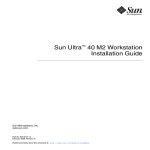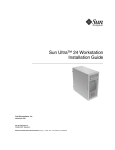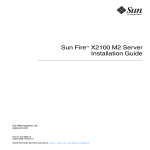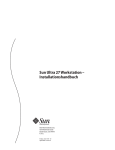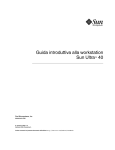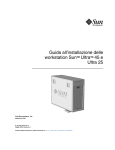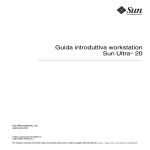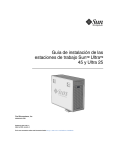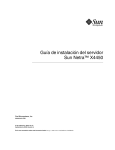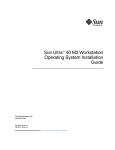Download Sun Ultra 20 M2 Workstation Installation Guide
Transcript
Sun Ultra™ 20 M2 Workstation Installation Guide Sun Microsystems, Inc. www.sun.com Part No. 819-6587-12 January 2007, Revision A Submit comments about this document at: http://www.sun.com/hwdocs/feedback Copyright © 2007 Sun Microsystems, Inc., 4150 Network Circle, Santa Clara, California 95054, U.S.A. All rights reserved. Sun Microsystems, Inc. has intellectual property rights relating to technology embodied in the product that is described in this document. In particular, and without limitation, these intellectual property rights may include one or more of the U.S. patents listed at http://www.sun.com/patents and one or more additional patents or pending patent applications in the U.S. and in other countries. Parts of the product may be derived from Berkeley BSD systems, licensed from the University of California. UNIX is a registered trademark in the U.S. and in other countries, exclusively licensed through X/Open Company, Ltd. Sun, Sun Microsystems, the Sun logo, Java, Solaris and NetBeans Sun Ultra are trademarks or registered trademarks of Sun Microsystems, Inc. in the U.S. and other countries. AMD, Opteron, the AMD logo, the AMD Opteron logo are trademarks or registered trademarks of Advanced Micro Devices. The PostScript logo is a trademark or registered trademark of Adobe Systems, Incorporated. Use of any spare or replacement CPUs is limited to repair or one-for-one replacement of CPUs in products exported in compliance with U.S. export laws. Use of CPUs as product upgrades unless authorized by the U.S. Government is strictly prohibited. DOCUMENTATION IS PROVIDED "AS IS" AND ALL EXPRESS OR IMPLIED CONDITIONS, REPRESENTATIONS AND WARRANTIES, INCLUDING ANY IMPLIED WARRANTY OF MERCHANTABILITY, FITNESS FOR A PARTICULAR PURPOSE OR NON-INFRINGEMENT, ARE DISCLAIMED, EXCEPT TO THE EXTENT THAT SUCH DISCLAIMERS ARE HELD TO BE LEGALLY INVALID. U.S. Government Rights—Commercial use. Government users are subject to the Sun Microsystems, Inc. standard license agreement and applicable provisions of the FAR and its supplements. Copyright © 2007 Sun Microsystems, Inc., 4150 Network Circle, Santa Clara, California 95054, Etats-Unis. Tous droits réservés. Sun Microsystems, Inc. détient les droits de propriété intellectuels relatifs à la technologie incorporée dans le produit qui est décrit dans ce document. En particulier, et ce sans limitation, ces droits de propriété intellectuelle peuvent inclure un ou plus des brevets américains listés à l'adresse http://www.sun.com/patents et un ou les brevets supplémentaires ou les applications de brevet en attente aux Etats - Unis et dans les autres pays. Des parties de ce produit pourront être dérivées des systèmes Berkeley BSD licenciés par l'Université de Californie. UNIX est une marque déposée aux Etats-Unis et dans d'autres pays et licenciée exclusivement par X/Open Company, Ltd. Sun, Sun Microsystems, le logo Sun, Java, Solaris et NetBeans Sun Ultra sont des marques de fabrique ou des marques déposées de Sun Microsystems, Inc. aux Etats-Unis et dans d'autres pays. AMD, Opteron, the AMD logo, the AMD Opteron logo are trademarks or registered trademarks of Advanced Micro Devices. Le logo PostScript est une marque de fabrique ou une marque déposée de Adobe Systems, Incorporated. L'utilisation de pieces detachees ou d'unites centrales de remplacement est limitee aux reparations ou a l'echange standard d'unites centrales pour les produits exportes, conformement a la legislation americaine en matiere d'exportation. Sauf autorisation par les autorites des EtatsUnis, l'utilisation d'unites centrales pour proceder a des mises a jour de produits est rigoureusement interdite. LA DOCUMENTATION EST FOURNIE "EN L'ETAT" ET TOUTES AUTRES CONDITIONS, DECLARATIONS ET GARANTIES EXPRESSES OU TACITES SONT FORMELLEMENT EXCLUES, DANS LA MESURE AUTORISEE PAR LA LOI APPLICABLE, Y COMPRIS NOTAMMENT TOUTE GARANTIE IMPLICITE RELATIVE A LA QUALITE MARCHANDE, A L'APTITUDE A UNE UTILISATION PARTICULIERE OU A L'ABSENCE DE CONTREFACON. Please Recycle Contents Preface 1. 2. v Introduction to the Sun Ultra 20 M2 Workstation Hardware 1.1 Safety Information 1.2 Planning the Installation Process 1.3 Inventorying Package Contents 1.4 Front Panel 1–4 1.5 Back Panel 1–5 1.6 Interior Components 1.7 Connecting External Devices to the Workstation 1.8 Powering On the Workstation 1–9 1.9 Powering Off the Workstation 1–9 1.10 Adding/Removing Devices To/From the Boot Menu 1–1 1–1 1–2 1–3 1–6 1–7 1–10 Configuring the Preinstalled Solaris OS and Using Preinstalled Developer Software 2–1 2.1 Configuring the Solaris 10 OS 2–1 2.1.1 Licensing Information 2–2 2.1.2 Disk Configuration 2.1.3 Installation Flowchart 2.1.4 Configuring the Preinstalled Solaris 10 OS 2–2 2–3 2–4 iii 2.2 2.3 3. 4. Exploring Preinstalled Developer Software 2.2.1 Sun Studio Software 2.2.2 Sun Java Studio Creator 2.2.3 Sun Java Studio Enterprise 2.2.4 NetBeans IDE 2–6 2–6 2–7 2–7 2–8 Restoring, Reinstalling, and Backing Up Preinstalled Software 2.3.1 Backing-up and Restoring the Solaris OS 2.3.2 Downloading Developer Software 2.3.3 Hard Drive Mirroring Solaris 1.2 Windows 1.3 Linux 2–9 2–9 Configuring the System for Dual Monitors 1.1 2–9 A–1 A–2 A–2 A–3 Troubleshooting Setup and Obtaining Technical Assistance 2.1 Troubleshooting the Sun Ultra 20 M2 Workstation Setup 2.2 Technical Assistance B–1 B–2 B–4 A. Tools and Drivers CD, Supported Operating Systems, and System Specifications C–1 iv C.1 Tools and Drivers CD Software C–1 C.2 Supported Operating System Software C.3 Sun Ultra 20 M2 Workstation Features and Specifications C–2 C.3.1 System Components and Features C.3.2 Memory Configurations C.3.3 PCI-E and PCI Expansion Slots C.3.4 Physical Specifications C.3.5 Power Specifications C.3.6 Environmental Specifications C–4 C–5 C–5 C–6 Sun Ultra 20 M2 Workstation Installation Guide • January 2007 C–3 C–7 C–3 2–8 Preface The Sun Ultra 20 M2 Workstation Installation Guide provides the information that you need to set up, power on, and configure the workstation hardware and software. How This Book Is Organized This guide is organized into the following chapters: Chapter 1 contains instructions on unpacking, cabling, and powering the workstation. Chapter 2 explains how to set up the preinstalled Solaris™ 10 Operating System and additional development software. Chapter B discusses troubleshooting system issues and obtaining support. Appendix C provides information regarding the Sun Ultra 20 M2 Workstation Tools and Drivers CD, supported operating systems, and system specifications. v Shell Prompts Shell Prompt C shell machine-name% C shell superuser machine-name# Bourne shell and Korn shell $ Bourne shell and Korn shell superuser # Typographic Conventions Typeface* Meaning Examples AaBbCc123 The names of commands, files, and directories; on-screen computer output Edit your.login file. Use ls -a to list all files. % You have mail. AaBbCc123 What you type, when contrasted with on-screen computer output % su Password: AaBbCc123 Book titles, new words or terms, words to be emphasized. Replace command-line variables with real names or values. Read Chapter 6 in the User’s Guide. These are called class options. You must be superuser to do this. To delete a file, type rm filename. * The settings on your browser might differ from these settings. vi Sun Ultra 20 M2 Workstation Installation Guide • January 2007 Related Documentation The document set for the Sun Ultra 20 M2 Workstation is described in the Where To Find Sun Ultra 20 M2 Workstation Documentation sheet that is packed with your system. All documents are posted at the product’s documentation site; see the following URL: http://www.sun.com/documentation Translated versions of some of these documents are available at the product’s documentation site in Simplified Chinese, Traditional Chinese, French, German, Italian, Japanese, Korean, and Spanish. English documentation is revised more frequently and might be more up-to-date than the translated documentation. Documentation, Warranty, Support, and Training URLs Sun Function URL Description Hardware Documentation http://www.sun.com/documentation Sun hardware documentation Software Documentation http://docs.sun.com Solaris OS and other software documentation Warranty http://www.sun.com/service/support/ warranty/index.html View specific details regarding your warranty Support http://www.sun.com/support/ Obtain technical support, including patches Training http://www.sun.com/training/ Learn about Sun courses and educational offerings Preface vii Ordering Components You can order additional components and replacement parts for the Sun Ultra 20 M2 Workstation. Contact your local Sun sales representative for more information. For the most up-to-date component information, see the Sun Ultra 20 M2 Workstation components list at: http://sunsolve.sun.com/handbook_pub/ Third-Party Web Sites Sun is not responsible for the availability of third-party web sites mentioned in this document. Sun does not endorse and is not responsible or liable for any content, advertising, products, or other materials that are available on or through such sites or resources. Sun will not be responsible or liable for any actual or alleged damage or loss caused by or in connection with the use of or reliance on any such content, goods, or services that are available on or through such sites or resources. Safety Information Read the following documents for safety information: ■ Important Safety Information for Sun Hardware Systems, 816-7190 ■ Sun Ultra 20 M2 Workstation Safety and Compliance Guide, 819-2149 viii Sun Ultra 20 M2 Workstation Installation Guide • January 2007 Sun Welcomes Your Comments Sun is interested in improving its documentation and welcomes your comments and suggestions. You can submit your comments by going to: http://www.sun.com/hwdocs/feedback/ Please include the title and part number of your document with your feedback: Sun Ultra 20 M2 Workstation Installation Guide, 819-6587-12. Preface ix x Sun Ultra 20 M2 Workstation Installation Guide • January 2007 CHAPTER 1 Introduction to the Sun Ultra 20 M2 Workstation Hardware This chapter provides an overview of the Sun Ultra 20 M2 Workstation hardware. This chapter includes the following sections: ■ ■ ■ ■ ■ ■ ■ ■ ■ ■ 1.1 Section 1.1, “Safety Information” on page 1-1 Section 1.2, “Planning the Installation Process” on page 1-2 Section 1.3, “Inventorying Package Contents” on page 1-3 Section 1.4, “Front Panel” on page 1-4 Section 1.5, “Back Panel” on page 1-5 Section 1.6, “Interior Components” on page 1-6 Section 1.7, “Connecting External Devices to the Workstation” on page 1-7 Section 1.8, “Powering On the Workstation” on page 1-9 Section 1.9, “Powering Off the Workstation” on page 1-9 Section 1.10, “Adding/Removing Devices To/From the Boot Menu” on page 1-10 Safety Information Read the following documents for safety information: ■ Important Safety Information for Sun Hardware Systems, 816-7190 ■ Sun Ultra 20 M2 Workstation Safety and Compliance Guide, 819-6585 1-1 1.2 Planning the Installation Process Use the following flowchart as a process tool to assist you with installation of the Sun Ultra 20 M2 Workstation. START Unpack the workstation and familiarize yourself with the workstation features. Install optional components? Yes See Section 1.4, “Front Panel” on page 1-4 and Section 1.5, “Back Panel” on page 1-5. Install optional components. To install DIMMs, graphic accelerators, PCI cards, hard drives, tape drives, or CD or DVD drives, see the Sun Ultra 20 M2 Workstation Service Manual. No Connect the workstation and external device cables. Power on the workstation. Configure preinstalled OS software? No See Section 1.7, “Connecting External Devices to the See Section 1.8, “Powering On the Workstation” on page 1-9. Install your OS. To install an optional, supported OS, see the Sun Ultra 20 M2 Workstation Operating System Guide. Yes Configure the preinstalled Solaris 10 Operating System. See Section 2.1, “Configuring the Solaris 10 OS” on page 2-1. READY TO WORK! See Appendix C and the Sun Ultra 20 M2 Workstation Operating System Guide. FIGURE 1-1 1-2 Process for Setting Up the Sun Ultra 20 M2 Workstation Sun Ultra 20 M2 Workstation Installation Guide • January 2007 1.3 Inventorying Package Contents Carefully unpack all workstation components from the packing cartons. The following items are contained in the package. TABLE 1-1 Items Included in the Sun Ultra 20 M2 Workstation Box Hardware • Sun Ultra 20 M2 Workstation • DMS-59 cable (if the workstation is configured with an NVS285 graphics card) Documentation • Sun Ultra 20 M2 Workstation Installation Guide (this document) • Where to Find Sun Ultra 20 M2 Workstation Documentation (lists available online documents for this product) • Sun safety, warranty, and license documents CD-ROM • Sun Ultra 20 M2 Workstation Tools and Drivers CD (includes drivers and diagnostics software) If you ordered an optional country kit, the kit ships in a separate package and includes a power cable, keyboard, and mouse. Note – Use only a Type 7 keyboard and Type 7 mouse with the Sun Ultra 20 M2 Workstation. Chapter 1 Introduction to the Sun Ultra 20 M2 Workstation Hardware 1-3 1.4 Front Panel FIGURE 1-2 illustrates the front panel of the Sun Ultra 20 M2 Workstation. TABLE 1-2 lists the components called out in the figure. 1-4 FIGURE 1-2 Front Panel Components TABLE 1-2 Front Panel Components Label Button/LED/Port Label Button/LED/port 1 Power button 4 Two USB 2.0 ports 2 Power LED 5 Microphone-in jack 3 Two 1394 ports 6 Headphone-out jack Sun Ultra 20 M2 Workstation Installation Guide • January 2007 1.5 Back Panel FIGURE 1-3 depicts the back panel of the Sun Ultra 20 M2 Workstation. TABLE 1-3 lists the components called out in the figure. FIGURE 1-3 Back Panel Components TABLE 1-3 Back Panel Components Label Connector/Slot Label Connector/Slot 1 Power connector 8 Four USB 2.0 connectors 2 Power switch 9 PCI Express x16 graphics slot 3 Onboard DB15 VGA graphics connector (for ES 1000 graphics controller) 10 PCI Express x1 slot 4 Line-in jack 11 PCI Express x16 mechanical slot (x8 electrical) 5 Line-out jack 12 Three PCI 33-MHz 32-bit slots 6 Microphone jack 13 Cover plate, no slot 7 Two Ethernet connectors Chapter 1 Introduction to the Sun Ultra 20 M2 Workstation Hardware 1-5 1.6 Interior Components FIGURE 1-4 illustrates some of the interior components of the Sun Ultra 20 M2 Workstation. TABLE 1-4 lists the items called out in the figure. For further information about PCI slots, see “PCI-E and PCI Expansion Slots” on page 5. For component installation, removal, and replacement procedures, see the Sun Ultra 20 M2 Workstation Service Manual. 1-6 FIGURE 1-4 Internal System Components TABLE 1-4 Internal System Components Label Component Label Component 1 Power supply 6 DVD release lever 2 Memory (DIMMs) 7 I/O board release thumbscrew 3 System fan 8 Heatsink release lever 4 PCI Express slots (3) numbered PCI-E slot 0 (top) to PCI-E slot 2 9 System serial number 5 PCI slots (3) numbered PCI slot 0 (top) to PCI slot 2 10 Hard disk drive(s) Sun Ultra 20 M2 Workstation Installation Guide • January 2007 1.7 Connecting External Devices to the Workstation FIGURE 1-5 illustrates the external device cable connections to the workstation. FIGURE 1-5 External Cable Connections Perform this procedure to connect external devices to the workstation. 1. Connect the workstation power cord to a grounded electrical outlet. 2. Connect the keyboard to a USB connector on the back or front panel. 3. Connect the mouse to the USB connector on the underside of the keyboard or to a USB connector on the front or back panel. 4. Connect the Ethernet cable to either Ethernet connector on the Sun Ultra 20 M2 Workstation, and connect the other end of the cable to an Ethernet RJ-45 jack. Chapter 1 Introduction to the Sun Ultra 20 M2 Workstation Hardware 1-7 5. Connect the monitor cable as follows: ■ If a PCI Express graphics card is not installed in the top PCI-E slot, connect the monitor to the onboard video connector. See the top of FIGURE 1-6. ■ If a PCI Express graphics card is installed in the top PCI-E slot, connect the monitor to the graphics card connector. See the bottom of FIGURE 1-6. Your graphics card might require a DVI cable to connect to your monitor. FIGURE 1-6 Connecting the Monitor to the System 6. Connect any additional external devices to the workstation’s other connectors. 1-8 Sun Ultra 20 M2 Workstation Installation Guide • January 2007 1.8 Powering On the Workstation Perform this procedure to power on the workstation. 1. Turn on the power to the monitor and to all external devices. 2. Turn the power switch on the rear of the workstation to the On ( | ) position. 3. Press and release the power switch on the front panel. 4. After several seconds, verify that the platform power LED next to the power switch is lit. The platform power LED lights after the workstation begins the internal booting process. 5. If you need to change the system parameters in the BIOS, press the F2 key during the POST process to access the BIOS Setup Utility. Caution – Be careful when making changes to the system BIOS, as some changes can cause your system to malfunction. 1.9 Powering Off the Workstation 1. Save your data and close any open applications. 2. Read both of the following power-off options, and then follow one of the options to turn off the workstation. ■ Power off the workstation by using the operating system shutdown command or menu option. In most cases, this initiates an orderly shutdown of the operating system and shuts off the workstation power. Caution – To avoid data loss, use the first option whenever possible. ■ If the first option does not shut off the workstation power, press and hold the power button for approximately four seconds. This option shuts down the power to the workstation but does not initiate an orderly shutdown of the operating system. This option might result in data loss. Chapter 1 Introduction to the Sun Ultra 20 M2 Workstation Hardware 1-9 If the proceeding options do not power off the workstation, turn the power switch on the back panel to the Off ( 0 ) position. After powering off the workstation, wait at least four seconds before powering on the workstation again. 1.10 Adding/Removing Devices To/From the Boot Menu The boot menu lists the devices from which the system can boot. If you want to boot from a newly installed or attached device, you must add it to the boot menu. To add or remove devices to/from the boot menu (accessed by pressing the F8 key during boot), perform the following steps: 1. Press the F2 key during system boot. The BIOS Setup screen displays. 2. In the Boot Settings menu, add or remove the device from the boot device list. 3. Press the F10 key to save your settings and exit. 1-10 Sun Ultra 20 M2 Workstation Installation Guide • January 2007 CHAPTER 2 Configuring the Preinstalled Solaris OS and Using Preinstalled Developer Software The Solaris™ 10 Operating System (OS) is preinstalled on the Sun Ultra 20 M2 Workstation, along with developer software. This chapter contains instructions for configuring the preinstalled Solaris 10 OS, and information regarding the developer software. To install Linux, Windows, or a different version of the Solaris OS, see the Sun Ultra 20 M2 Workstation Operating System Installation Guide, available on the Sun documentation web site. Also, refer to Appendix C for a list of supported operating systems. This chapter contains the following sections: ■ ■ ■ 2.1 Section 2.1, “Configuring the Solaris 10 OS” on page 2-1 Section 2.2, “Exploring Preinstalled Developer Software” on page 2-6 Section 2.3, “Restoring, Reinstalling, and Backing Up Preinstalled Software” on page 2-8 Configuring the Solaris 10 OS The following topics are covered in this section: ■ Section 2.1.1, “Licensing Information” on page 2-2 ■ Section 2.1.2, “Disk Configuration” on page 2-2 ■ Section 2.1.3, “Installation Flowchart” on page 2-3 ■ Section 2.1.4, “Configuring the Preinstalled Solaris 10 OS” on page 2-4 2-1 2.1.1 Licensing Information The Solaris 10 OS installed on your system requires no licensing fee. The Sun Ultra 20 M2 Workstation requires Solaris 10 6/06 or a subsequent compatible version of the Solaris OS. For more information, refer to the following web site: http://wwws.sun.com/software/solaris/licensing/index.html 2.1.2 Disk Configuration The exact disk configuration that is preinstalled is as follows: 2-2 ■ Hard drive root partition—14.0-GB ■ Hard drive swap partition—2.0-GB ■ Hard drive var partition—6.0-GB ■ Hard drive export partition—remainder of the disk Sun Ultra 20 M2 Workstation Installation Guide • January 2007 2.1.3 Installation Flowchart Use the flowchart in FIGURE 2-1 to assist with setting up your OS. START Power on the system. Use a preinstalled version of software? No See “Section 1.8, “Powering On the Workstation” on page 1-9. Install different OS from other media. For instructions, refer to Appendix C, the Sun Ultra 20 M2 Workstation Operating System Installation Guide, and the documentation for your OS. Yes Configure the Solaris 10 OS. Explore developer software. See Section 2.1.4, “Configuring the Preinstalled Solaris 10 OS” on See Section 2.2, “Exploring Preinstalled Developer Software” on READY TO WORK! FIGURE 2-1 Installation Flow Diagram Chapter 2 Configuring the Preinstalled Solaris OS and Using Preinstalled Developer Software 2-3 2.1.4 Configuring the Preinstalled Solaris 10 OS Complete the following steps to configure the preinstalled Solaris 10 OS. 1. Power on the workstation. See Section 1.8, “Powering On the Workstation” on page 1-9. 2. Answer the setup prompts by following the on-screen instructions. Use a copy of TABLE 2-1 to write down the information that you might need to collect before setting up the Solaris 10 OS. To help you fill out the information in the table, your system administrator (SA) should provide you with information specific to your site before you begin. Check with your SA about whether some of the information is available on your network. Note – When you originally configure your system, under Xserver Selection, you will be given a choice of Xorg server or Xsun server. Choose Xorg server. 3. When you finish the configuration, the system reboots. The workstation displays the login window. 4. Type your user name and password to log in and begin using the workstation. 5. Review the Solaris 10 Operating System Release Notes for any late-breaking information about your preinstalled software. The Solaris 10 Operating System Release Notes documentation is located at the following web site: http://docs.sun.com 2-4 Sun Ultra 20 M2 Workstation Installation Guide • January 2007 TABLE 2-1 Information for Preinstalled Solaris 10 OS Configuration Setup Window Explanation and Notes Select Language and Locale Native language and locale to use for the workstation. Host Name A name to give the workstation. Terminal Type Type of terminal to use on the workstation. Network Connectivity Network or standalone workstation protocols. A system administrator might be required to complete this section. Your Information (IP Address) Note: Depending on how you answer and what information is provided by your network, you might also be prompted for the workstation’s IP address. IPv6 Option to enable IPv6 on the workstation. Security Settings Security settings and protocols. Name Service Name service to use: NIS+, NIS, DNS, LDAP, or None. Note: This window displays only if the workstation is connected to a network. Domain Name NIS or NIS+ domain for this workstation. Note: This window displays only if you specify NIS or NIS+ as the Name Service. Name Server/ Subnet/ Subnet Mask Name server (specify the server or have the workstation find one on a local subnet). Note: This window displays only if the workstation is connected to a network. Note: Depending on how you answer and what information is provided by your network, you might also be prompted for: • The subnet for the workstation • The subnet mask for the workstation Time Zone Local time zone (select by geographic region, GMT offset, or a time zone file). Chapter 2 Configuring the Preinstalled Solaris OS and Using Preinstalled Developer Software 2-5 TABLE 2-1 Information for Preinstalled Solaris 10 OS Configuration (Continued) Setup Window Explanation and Notes Date and Time Current date and time (accept the default or enter the current date and time). Root Password Root (superuser) password for the workstation. Proxy Server Configuration Workstation connection: direct to the Internet or through a proxy server. 2.2 Your Information Exploring Preinstalled Developer Software The following minimum versions of Sun’s developer software are preinstalled or preloaded onto your Sun Ultra 20 M2 Workstation. An overview of each developer software package is presented in the following sections. ■ ■ ■ ■ Sun Studio 11 (see Section 2.2.1, “Sun Studio Software” on page 2-6) Sun Java Studio Creator 2 (see Section 2.2.2, “Sun Java Studio Creator” on page 2-7) Sun Java Studio Enterprise 8 (see Section 2.2.3, “Sun Java Studio Enterprise” on page 2-7) NetBeans IDE 5.0 (Section 2.2.4, “NetBeans IDE” on page 2-8) Your system might have later versions of this software preinstalled. 2.2.1 Sun Studio Software Sun Studio software provides a comprehensive, productive environment for developing reliable, scalable, high-performance applications using C, C++, and FORTRAN for the Solaris OS. The software package includes compilers, performance analysis tools, and a powerful debugger, as well as an integrated development environment (IDE). The Sun Studio IDE provides modules for creating, editing, building, debugging, and analyzing the performance of C, C++, or FORTRAN applications. It includes a set of basic Java™ language support modules that can be enabled if needed for JNI (Java Native Interface) development. The Sun Studio software consists of two major components: 2-6 Sun Ultra 20 M2 Workstation Installation Guide • January 2007 ■ The Sun Studio component, which includes the IDE, compilers, tools, and core platform ■ The Java 2 Platform, Standard Edition (J2SE) technology on which the core platform runs For more information regarding the Sun Studio software, see the product documentation at the following web site: http://developers.sun.com/sunstudio 2.2.2 Sun Java Studio Creator The Sun Java Studio Creator development environment (formerly “Project Rave”) is the next-generation tool for Java application development. This product combines the power of 100% Java standards with simplified visual development techniques to give developers the most effective, most productive way to build applications in Java. The Java Studio Creator environment was designed and tested to meet the needs of skilled developers whose primary concern is rapid turnaround of business-critical applications. Java Studio Creator enables these developers to leverage the power of the Java platform to solve business problems, without forcing them to give up the highly-productive, visual style to which they are accustomed. For additional information about Sun Java Studio Creator, see the product documentation at the following web site: http://developers.sun.com/jscreator 2.2.3 Sun Java Studio Enterprise Sun Java Studio Enterprise is a complete, cost-effective, unified platform of tools, support, and services designed to fully integrate with the capabilities of the Sun Java Enterprise System. Java Studio Enterprise enables you to develop applications in an environment carefully designed to: ■ Improve productivity ■ Simplify the creation of sophisticated network applications that are ready to be deployed on the Java Enterprise System For additional information about Sun Java Studio Enterprise, see the product documentation at the following web site: http://developers.sun.com/jsenterprise Chapter 2 Configuring the Preinstalled Solaris OS and Using Preinstalled Developer Software 2-7 2.2.4 NetBeans IDE The NetBeans IDE 5.0 includes Java 2 Platform, Enterprise Edition (J2EE) development capabilities. This new release enables developers to not only develop applications in the web tier, but also includes Enterprise JavaBeans (EJBs) and web service development capabilities. The NetBeans IDE is a single platform with out-of-the-box development capabilities and support for enterprise (J2EE 1.4) applications and web services, mobile/wireless Java 2 Platform, Micro Edition (J2ME) applications and services, and desktop Java 2 Platform, Standard Edition (J2SE) applications. The robust open source Java IDE, has everything that Java software developers need to develop cross-platform desktop, web, and mobile applications straight out of the box. For more information about the NetBeans IDE, see the following website: http://www.netbeans.org 2.3 Restoring, Reinstalling, and Backing Up Preinstalled Software The hard disk drive for your system contains preinstalled software, including the Solaris 10 OS, developer software, and other applications. The preinstalled OS is preconfigured with drivers required to support the workstation’s hardware. The Solaris 10 6/06 OS (or a later, compatible version) is available for download, as are the developer applications, drivers, and other applications. However, if you reinstall the OS, you will need to follow the instructions in the Sun Ultra 20 M2 Workstation Operating System Installation Guide to configure the OS and install the drivers. Instead of downloading software, you can purchase the Solaris 10 media from the following web site: http://store.sun.com/ 2-8 Sun Ultra 20 M2 Workstation Installation Guide • January 2007 2.3.1 Backing-up and Restoring the Solaris OS To restore the Solaris OS, make and keep a full backup of the OS. The Solaris 10 System Administration Collection includes instructions for backing up your OS and is available on the following web site: http:/docs.sun.com/ 2.3.2 Downloading Developer Software You can download the developer software packages from the following web sites. The sites contain the software packages, updates, documentation, and more. If you purchased the Solaris 10 media, some of the software is included on the media. Software Package Download Site Sun Studio http://developers.sun.com/sunstudio Java Studio Enterprise http://developers.sun.com/jsenterprise Java Studio Creator http://developers.sun.com/jscreator NetBeans http://www.netbeans.org 2.3.3 Hard Drive Mirroring To perform hard drive mirroring using the Solaris 10 operating environment, use Solaris Volume Manager. For information about Solaris Volume Manager, see the Solaris Volume Manager Administration Guide at the following web site: http://www.sun.com/documentation/ Chapter 2 Configuring the Preinstalled Solaris OS and Using Preinstalled Developer Software 2-9 2-10 Sun Ultra 20 M2 Workstation Installation Guide • January 2007 APPENDIX A Configuring the System for Dual Monitors This chapter describes how to configure the following operating systems for dual monitors: ■ Section 1.1, “Solaris” on page A-2 ■ Section 1.2, “Windows” on page A-2 ■ Section 1.3, “Linux” on page A-3 A-1 1.1 Solaris To configure Solaris for dual monitors, follow these steps: 1. Install the two video cards you intend to use, attach monitors to the cards, and boot the system. Note – X-windows may not start, initially, due to the change in configuration. The system outputs to PCI-E slot 2 (lower slot) until X-windows comes up. 2. When the system boots, insert the Tools and Drivers CD, and change directory to the following location: /cdrom/<T&D_disk_name>/drivers/solx86 3. Run the install.sh and the dual_monitor.sh scripts. 4. Reboot the system. The dual monitors should come up. 5. To change from Clone to Xinerama modes, edit the file /etc/X11/xorg.conf and turn the appropriate settings in the file on or off. 1.2 Windows To configure Windows for dual monitors, follow these steps: 1. Install the two cards which you wish to use, attach monitors to the cards, and boot the system. The system outputs to PCI-E slot 2 (lower slot) until X-windows comes up. 2. When the system boots, insert the Tools and Drivers CD, and change directory to the following location: /cdrom/<T&D_disk_name>/drivers/winxp 3. Change to the appropriate OS (32- or 64-bit) and load the video drivers. 4. Reboot the system. A-2 Sun Ultra 20 M2 Workstation Installation Guide • January 2007 5. Open Control Panel > Display > Settings to adjust the parameters of the two screens. You may have to choose Extend Desktop to this monitor for the secondary screen. 6. Adjust the parameters as desired. A second reboot may be necessary for the system to see both screens. 1.3 Linux To configure Linux for dual monitors, follow these steps: 1. Install the two cards which you wish to use, attach monitors to the cards, and boot the system. Note – X-windows may not start, initially, due to the change in configuration. The system outputs to PCI-E slot 2 (lower slot) until X-windows comes up. 2. When the system boots, insert the Tools and Drivers CD, and change directory to the following location: /cdrom/<T&D_disk_name>/drivers/linux/<OS> where OS can be either redhat or suse. 3. Run the install.sh script. 4. Change directory to the following location: /etc/X11 5. Copy the current xorg.conf (or XF86Config) file to a backup file. 6. Edit the xorg.conf file to add the new screens and cards. Note – The top card is at PCI address (2,0,0) and the bottom is at (7,0,0). Appendix A Configuring the System for Dual Monitors A-3 An example xorg.conf file is shown below: # nvidia-xconfig: X configuration file generated by nvidia-xconfig # nvidia-xconfig: version 1.0 (buildmeister@builder26) Mon Oct 16 22:13:48 PDT 2006 # XFree86 4 configuration created by pyxf86config #Section "ServerLayout" # Identifier # Screen "Default Layout" # InputDevice "Mouse0" "CorePointer" # InputDevice "Keyboard0" "CoreKeyboard" 0 "Screen0" 0 0 #EndSection Section "ServerLayout" Identifier # "Default Layout" Screen 0 Screen 1 "Screen 0" "Screen 1" RightOf "Screen 0" Screen 2 "Screen 2" LeftOf "Screen 1" InputDevice "Mouse0" "CorePointer" InputDevice "Keyboard0" "CoreKeyboard" EndSection Section "Files" # RgbPath is the location of the RGB database. Note, this is the name of the # file minus the extension (like ".txt" or ".db"). There is normally # no need to change the default. # Multiple FontPath entries are allowed (they are concatenated together) # By default, Red Hat 6.0 and later now use a font server independent of # the X server to render fonts. RgbPath "/usr/X11R6/lib/X11/rgb" FontPath "unix/:7100" EndSection Section "Module" Load "dbe" Load "extmod" Load "fbdevhw" Load "glx" Load "record" Load "freetype" Load "type1" EndSection A-4 Sun Ultra 20 M2 Workstation Installation Guide • January 2007 Section "InputDevice" # Specify which keyboard LEDs can be user-controlled (eg, with xset(1)) # Option "Xleds" "1 2 3" # To disable the XKEYBOARD extension, uncomment XkbDisable. # Option "XkbDisable" # To customise the XKB settings to suit your keyboard, modify the # lines below (which are the defaults). For example, for a non-U.S. # keyboard, you will probably want to use: # Option "XkbModel" "pc102" # If you have a US Microsoft Natural keyboard, you can use: # Option "XkbModel" "microsoft" # # Then to change the language, change the Layout setting. # For example, a german layout can be obtained with: # Option "XkbLayout" "de" # Option "XkbLayout" "de" # Option "XkbVariant" "nodeadkeys" # or: # # If you’d like to switch the positions of your capslock and # control keys, use: # Option "XkbOptions" "ctrl:swapcaps" # Or if you just want both to be control, use: # Option "XkbOptions" "ctrl:nocaps" # Identifier "Keyboard0" Driver "kbd" Option "XkbModel" "pc105" Option "XkbLayout" "us" EndSection Section "InputDevice" Identifier "Mouse0" Driver "mouse" Option "Protocol" "IMPS/2" Option "Device" "/dev/input/mice" Option "ZAxisMapping" "4 5" Option "Emulate3Buttons" "yes" EndSection Appendix A Configuring the System for Dual Monitors A-5 Section "Monitor" Identifier "Monitor0" VendorName "Monitor Vendor" ModelName "Unprobed Monitor" HorizSync VertRefresh Option 31.5 - 67.0 50.0 - 75.0 "dpms" EndSection Section "Monitor" Identifier "Monitor1" VendorName "Sun Microsystems" ModelName "X7198A" HorizSync VertRefresh Option 31.5 - 67.0 50.0 - 75.0 "dpms" EndSection Section "Device" Identifier "Videocard0" Driver "nvidia" VendorName "Videocard vendor" BoardName "VESA driver (generic)" BusID "PCI:2:0:0" EndSection Section "Device" Identifier "Videocard1" Driver "nvidia" VendorName "Videocard vendor" BoardName "VESA driver (generic)" BusID "PCI:7:0:0" EndSection Section "Screen" Identifier "Screen 0" Device "Videocard0" Monitor "Monitor0" DefaultDepth A-6 24 Option "TwinView" "True" Option "TwinViewOrientation" "LeftOf" Option "UseEdidFreqs" "True" Option "MetaModes" "800x600,800x600" Sun Ultra 20 M2 Workstation Installation Guide • January 2007 SubSection Viewport Depth Modes "Display" 0 0 24 "800x600" "640x480" EndSubSection EndSection Section "Screen" Identifier "Screen 1" Device "Videocard1" Monitor "Monitor1" DefaultDepth 24 Option "TwinView" "True" Option "TwinViewOrientation" "LeftOf" Option "UseEdidFreqs" "True" Option SubSection Viewport Depth Modes "MetaModes" "1024x768, 1024x768" "Display" 0 0 24 "800x600" "640x480" EndSubSection EndSection Appendix A Configuring the System for Dual Monitors A-7 A-8 Sun Ultra 20 M2 Workstation Installation Guide • January 2007 APPENDIX B Troubleshooting Setup and Obtaining Technical Assistance This chapter contains information to help you troubleshoot minor system problems, and includes information on the following topics: ■ Section 2.1, “Troubleshooting the Sun Ultra 20 M2 Workstation Setup” on page B-2 ■ Section 2.2, “Technical Assistance” on page B-4 B-1 2.1 Troubleshooting the Sun Ultra 20 M2 Workstation Setup If you experience problems while setting up your system, refer to the troubleshooting information in TABLE 2-1. For additional troubleshooting information, see the Sun Ultra 20 M2 Workstation Service Manual. TABLE 2-1 Troubleshooting Procedures Problem Possible Solution System powers on, but the monitor does not. • • • • CD or DVD does not eject from the media tray when you press the Eject button. • Move the mouse or press any key on the keyboard. The drive might be in low-power mode. • Use the utility software installed on your system to eject the CD. No video displays on the monitor screen. • Is the monitor cable attached to the onboard video connector or PCI Express video connector? • Does the monitor work when connected to another system? • If you have a known-good monitor, does it work when connected to this system? • Verify that the BIOS settings are correct. • Review the Sun Ultra 20 M2 Workstation Product Notes for any issues that might impact your specific software and hardware configuration. System does not power on when the front panel Power button is pressed. Keep notes on the following situations in case you need to call service: • Is the power switch on the back of the system turned on (see FIGURE 1-3)? • Is the Power button LED illuminated on the front of the system? (Ensure that the power cord is connected to the system and to a grounded power receptacle.) • Does the wall outlet have power? Test by plugging in another device. • Do you hear a beep when the system is powered on? (Ensure that the keyboard is plugged in.) • Test with another keyboard that you know is functional. Do you hear a beep when you connect the keyboard and power on the system? • Does the monitor synchronize within 5 minutes after power on? (The green LED on the monitor stops flashing and remains illuminated.) B-2 Is the Power button for the monitor turned on? Is the monitor power cord connected to a wall outlet? Does the wall outlet have power? Test by plugging in another device. Is the monitor connected to the onboard video connector or PCI Express video connector? Sun Ultra 20 M2 Workstation Installation Guide • January 2007 TABLE 2-1 Troubleshooting Procedures (Continued) Problem Possible Solution Keyboard or mouse does not respond to actions. • Verify that the keyboard cable is connected to an on-board USB 2.0 connector on the system, and that the mouse is connected to a USB connector on the keyboard or on the system. • Verify that the system is powered on and the front Power LED is illuminated. System appears to be in low-power mode, but the Power button LED does not blink. The power-indicator LED blinks only when all system components are in low-power mode. A tape drive might be connected to your system. Because tape drives do not enter low-power mode, the power-indicator LED does not blink. Hung or frozen system: No response from mouse, keyboard, or any application. Are the keyboard and mouse Type 7? (Verify the model on the underside of the keyboard). Try to access your system from another system on the network. 1. From a terminal window, type ping hostname 2. If there is no response, remotely log in from another system using telnet or rlogin, and type the ping hostname command again. 3. Attempt to terminate processes until the system responds. If the above procedure does not work: 1. Press the Power button to power off the system. 2. Wait 20 to 30 seconds and power on the system. Appendix B Troubleshooting Setup and Obtaining Technical Assistance B-3 2.2 Technical Assistance If the troubleshooting procedures in this chapter fail to solve your problem, use TABLE 2-2 to collect information that you might need to communicate to the support personnel. TABLE 2-3 lists Sun web sites and telephone numbers for additional technical support. You can also refer to the web sites listed in “Documentation, Warranty, Support, and Training URLs” on page vii. TABLE 2-2 System Information Required for Support System Configuration Information Needed Your Information Sun service contract number System model Operating system, including service pack number or update number System serial number Peripherals attached to the system Hardware configuration information, including the following: • Graphics card installed • PCI or PCI Express cards installed • Amount of memory • Processor speed • Optical disk type Email address and phone number for you and a secondary contact Street address where the system is located Superuser password Summary of the problem and the work being done when the problem occurred Output of diagnostics test, if applicable Other useful information IP address B-4 Sun Ultra 20 M2 Workstation Installation Guide • January 2007 TABLE 2-2 System Information Required for Support (Continued) System Configuration Information Needed Your Information Workstation name (system host name) Network or Internet domain name Proxy server configuration TABLE 2-3 Sun Web Sites and Telephone Numbers Workstation Documents and Support Resources URL or Telephone Number Discussion and troubleshooting forums http://supportforum.sun.com/ Support, diagnostic tools, and alerts for all Sun products http://www.sun.com/bigadmin/ Software patches, lists of system specifications, troubleshooting and maintenance information, and other tools http://www.sunsolve.sun.com/handbook_pub/ Service support phone numbers 1-800-872-4786 (1-800-USA-4Sun) Select Option 1 International telephone numbers for SunService Support http://www.sun.com/service/contacting/solution.html Warranty and contract support contacts; Links to other service tools http://www.sun.com/service/warrantiescontracts/ Warranties for every Sun product http://www.sun.com/service/warranty Appendix B Troubleshooting Setup and Obtaining Technical Assistance B-5 B-6 Sun Ultra 20 M2 Workstation Installation Guide • January 2007 APPENDIX C Tools and Drivers CD, Supported Operating Systems, and System Specifications This appendix contains the following sections: ■ ■ ■ “Tools and Drivers CD Software” on page 1 “Supported Operating System Software” on page 2 “Sun Ultra 20 M2 Workstation Features and Specifications” on page 3 For maximum reliability and performance, install your system into an appropriate environment and ensure correct configuration as discussed in this document. C.1 Tools and Drivers CD Software The Sun Ultra 20 M2 Workstation Tools and Drivers CD, included with the workstation, contains the following software: ■ Supplemental drivers to support preinstalled, or supported and user-installed, operating systems. See the Sun Ultra 20 M2 Workstation Operating System Guide for information on installing these drivers. ■ Eurosoft Pc-Check diagnostics software, which provides various diagnostics testing options for the Sun Ultra 20 M2 Workstation. See the Sun Ultra 20 M2 Workstation Service Manual for more information. ■ Erase Primary Boot Hard Disk utility to erase the preinstalled operating system. ■ XpReburn utility to add drivers to an existing XP installation CD. ■ Open DOS. C-1 C.2 Supported Operating System Software The Solaris 10 6/06 OS is preinstalled on the Sun Ultra 20 M2 Workstation. Previous versions of the Solaris OS are not supported. The following operating systems (or later versions) are also supported for this workstation: ■ Red Hat Enterprise Linux 3 WS Update 7, 32-bit and 64-bit ■ Red Hat Enterprise Linux 4 WS Update 3, 32-bit and 64-bit ■ SUSE Linux Enterprise Server 9 SP 3, 64-bit only ■ Windows XP, 32-bit (SP2) and 64-bit (WHQL certified) For an updated list of supported operating systems, refer to the following web site: http://www.sun.com/ultra20 You can order Red Hat Enterprise Linux WS or SUSE Linux Enterprise Server for the Sun Ultra 20 M2 Workstation from the following Sun web site: http://wwws.sun.com/software/linux/index.html Follow the installation instructions provided with the operating systems. The Sun Ultra 20 M2 Workstation Operating System Guide contains instructions and information relating to driver installation for supported operating systems. C-2 Sun Ultra 20 M2 Workstation Installation Guide • January 2007 C.3 Sun Ultra 20 M2 Workstation Features and Specifications C.3.1 System Components and Features TABLE C-1 shows the system’s key components. TABLE C-1 Sun Ultra 20 M2 Workstation Components Component Description CPU • One dual-core AMD Opteron processor • Processor frequencies: 1.8 GHz and faster • 1 MB Level 2 Cache per processor core Memory • Four DIMM slots • 512 MB, 1 GB, 2 GB unbuffered DDR2-667, unbuffered, ECC DIMM modules supported (see Section C.3.2, “Memory Configurations” on page C-4) Media storage DVD-ROM or DVD-Dual Hard disk drives Up to two SATA disk drives Power supply 400W PSU Network I/O Onboard 10/100/1000BASE-T Gigabit Ethernet controller providing 2 RJ45 connectors on the back panel Video Onboard ATI graphics controller with DB15 VGA graphics connector PCI-E I/O and PCI I/O (see Section C.3.3, “PCIE and PCI Expansion Slots” on page C-5) • One PCI Express x16 graphics slot • One PCI Express x1 expansion slot • One PCI Express x16 mechanical connector slot (PCI-E x8 electrical) • Three PCI 33 MHz 32-bit slots Other I/O • Six USB 2.0 connectors (two on the front and four on the back of the workstation) • Two IEEE 1394 connectors on the front panel • Line-in/line-out jacks on the back panel • Microphone-in jack on the front and back panels • Headphone-out jack on the front panel Appendix C Tools and Drivers CD, Supported Operating Systems, and System Specifications C-3 C.3.2 Memory Configurations TABLE C-2 lists the possible memory configurations for the Sun Ultra 20 M2 Workstation. The system requires DDR2-667, unbuffered, ECC DIMMs installed in pairs (except the base 512 MB configuration). You can purchase DIMM kits at: http://store.sun.com DIMM slots are numbered from DIMM 0 to DIMM 3. Populate DIMM slots starting farthest from the CPU (that is, starting with slot 3). TABLE C-2 C-4 Sun Ultra 20 M2 Workstation Memory Configurations Total Memory Supported DIMM Configuration 1 512 MB 1 x 512 MB 1 GB 2 x 512 MB 2 GB 2 x 1 GB 3 GB 2 x 1 GB and 2 x 512 MB 4 GB 2 x 2 GB 5 GB 2 x 2 GB and 2 x 512 MB 6 GB 2 x 2 GB and 2 x 1 GB 8 GB 4 x 2 GB Sun Ultra 20 M2 Workstation Installation Guide • January 2007 Supported DIMM Configuration 2 4 x 512 MB 4 x 1 GB C.3.3 PCI-E and PCI Expansion Slots TABLE C-3 lists the characteristics of the available PCI-E and PCI expansion slots. TABLE C-3 Internal Expansion Slots Slot Connector Type Length Height Description Position 0 PCI-Express x16 (x16 electrical) x16 Full Nearest to power supply. For FX 3500, FX 1500, FX 560, or NVS 285 graphics accelerator, or any PCI-Express expansion cards such as NIC adapters. Top 1 PCI-Express x1 x1 Full Not for graphics accelerators. Intended for PCI-Express expansion cards such as NIC. Middle 2 PCI-Express x16 mechanical (x8 electrical) x16 Full Not for graphics accelerators. Intended for PCI-Express expansion cards such as NIC. Bottom 0 Conventional PCI (PCI v2.3 32-bit/33 Mhz, 5V) Full Full Open slot. Accommodates only 32-bit cards. 64-bit cards will not fit on the motherboard. Top 1 Conventional PCI (PCI v2.3 32-bit/33 Mhz, 5V) Full Full Open slot. Accommodates 64-bit PCI cards, but cards operate in 32-bit mode. Middle 2 Conventional PCI (PCI v2.3 32-bit/33 Mhz, 5V) Full Full Open slot (farthest from power supply). Accommodates 64-bit PCI cards, but cards operate in 32-bit mode. Bottom C.3.4 Physical Specifications TABLE C-4 lists the physical specifications for the Sun Ultra 20 M2 Workstation. TABLE C-4 Sun Ultra 20 M2 Workstation Physical Specifications Specification British Metric Width 7.9 in. 200 mm Depth 18.5 in. 470 mm Height 17.1 in. 435 mm Weight (max with packaging) 34 lb 15.4 kg Appendix C Tools and Drivers CD, Supported Operating Systems, and System Specifications C-5 C.3.5 Power Specifications The maximum continuous power for the Sun Ultra 20 M2 Workstation is 400W. TABLE C-5, TABLE C-6, and TABLE C-7 list additional power specifications for the system. TABLE C-5 Input Voltage Range Input Voltage Minimum Maximum Units Range 1 90 115 132 Vrms Range 2 180 230 264 Vrms Nominal Maximum Units TABLE C-6 Input Frequency Range Input Frequency Minimum Range 1 57 60 63 Hz Range 2 47 50 53 Hz TABLE C-7 C-6 Nominal Input Current Input Voltage Maximum Input Current Maximum Inrush Current Range 1 10A 50 Apeak Range 2 5A 100 Apeak Sun Ultra 20 M2 Workstation Installation Guide • January 2007 C.3.6 Environmental Specifications TABLE C-8 lists the environmental specifications for the Sun Ultra 20 M2 Workstation. TABLE C-8 Sun Ultra 20 M2 Workstation Environmental Specifications Specification State British Metric Humidity Operating 7%–93% RH noncondensing, 100.4˚ F max wet bulb 7%–93% RH noncondensing, 38˚ C max wet bulb Nonoperating 93% RH, noncondensing, 109.4˚ F max wet bulb 93% RH, noncondensing, 43˚ C max wet bulb Operating 0.25G in all axes, 5–500 Hz sine Nonoperating 1.2G in all axes, 5–500 Hz sine Shock Operating 4.5G, 11 msec. half-sine Temperature Operating 41˚ F to 95˚ F 5˚ C to 35˚ C Nonoperating –40˚ F to 149˚ F –40˚ C to 65˚ C –1.8˚ F for every 985 ft in altitude –1˚ C for every 300 m in altitude Operating max 9,843 ft max 3,000 m Nonoperating max 39,370 ft max 12,000 m Vibration Maximum operating temperature rating Altitude Appendix C Tools and Drivers CD, Supported Operating Systems, and System Specifications C-7 C-8 Sun Ultra 20 M2 Workstation Installation Guide • January 2007




















































